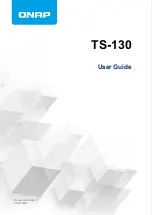
Selecting the boot mode
This server provides two
Boot Mode configurations: UEFI Mode and Legacy BIOS Mode. Certain boot options require that
you select a specific boot mode. By default, the boot mode is set to
UEFI Mode. The system must boot in UEFI Mode to
use certain options, including:
• Secure Boot, UEFI Optimized Boot, Generic USB Boot, IPv6 PXE Boot, iSCSI Boot, and Boot from URL
• Fibre Channel/FCoE Scan Policy
NOTE: The boot mode you use must match the operating system installation. If not, changing the boot mode can impact
the ability of the server to boot to the installed operating system.
Prerequisite
When booting to
UEFI Mode, leave UEFI Optimized Boot enabled.
Procedure
1. From the System Utilities screen, select System Configuration > BIOS/Platform Configuration (RBSU) > Boot
Options > Boot Mode.
2. Select a setting.
•
UEFI Mode (default)—Configures the system to boot to a UEFI compatible operating system.
•
Legacy BIOS Mode—Configures the system to boot to a traditional operating system in Legacy BIOS compatibility
mode.
3. Save your setting.
4. Reboot the server.
Secure Boot
Secure Boot is a server security feature that is implemented in the BIOS and does not require special hardware. Secure
Boot ensures that each component launched during the boot process is digitally signed and that the signature is validated
against a set of trusted certificates embedded in the UEFI BIOS. Secure Boot validates the software identity of the
following components in the boot process:
• UEFI drivers loaded from PCIe cards
• UEFI drivers loaded from mass storage devices
• Preboot UEFI Shell applications
• OS UEFI boot loaders
When Secure Boot is enabled:
• Firmware components and operating systems with boot loaders must have an appropriate digital signature to execute
during the boot process.
• Operating systems must support Secure Boot and have an EFI boot loader signed with one of the authorized keys to
boot. For more information about supported operating systems, see
https://www.hpe.com/servers/ossupport.
Software and configuration utilities
129
Summary of Contents for ProLiant DL325 Gen10 Plus
Page 36: ...10 Remove the inner drive cage blank 11 Remove the fan wall covers 36 Operations...
Page 37: ...12 For SFF drive cage remove the cable covers 13 Remove the drive cage latches Operations 37...
Page 38: ...14 Remove the outer drive cage LFF SFF 38 Operations...
Page 52: ...52 Operations...
Page 67: ...3 Remove the drive blank LFF SFF 4 Prepare the drive LFF Hardware options installation 67...
Page 119: ...SFF Cable routing Front I O LFF Cabling 119...
Page 120: ...SFF Cable routing Serial port 120 Cabling...
















































